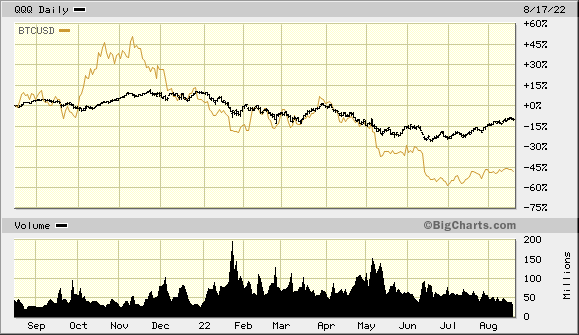The mathematics behind cryptocurrency
In a previous Mathematical Investor blog, we presented an overview of the mathematics behind blockchain technology, which is the basis of all cryptocurrency systems. At the present time, most systems are based on the SHA-256 algorithm, which is a specific instance of the Elliptic curve digital signature algorithm.
To attempt to break SHA-256 by brute force computation, one would need to exhaust over 2256 ≈ 1077 possible private keys, which is comparable to the number of atoms in the visible universe. In other words, while the computations necessary to actually perform a real-world blockchain operation are nontrivial, the computations necessary to break a blockchain operation are many times more expensive. Thus the mathematical structures behind blockchain are regarded as highly secure, both for conventional computer technology and also for emerging quantum computers, at least for the foreseeable future.
Nonetheless, the cryptocurrency world has recently been rocked by numerous high-profile losses. These range from consumer scams to hacks and other failures at prominent cryptocurrency exchanges. These losses are almost always due to mistakes and oversights by humans, rather than by breaking the underlying cryptosystems. In general, cryptocurrency investments effectively transfer responsibility for managing assets to individuals, who must either personally store the cryptocurrency digital keys, or else rely on an exchange, which itself might be vulnerable to a computer hacks or other human failings. In this article, we will present examples of some of the most common failures.
Lost cryptocurrency assets
One very important risk that many cryptocurrency users fail to recognize is that there is no recourse if they lose their digital keys. In 2013, for instance, a computer scientist mistakenly disposed of a hard drive containing keys for 8,000 Bitcoins in a landfill. At today’s market price [16 Aug 2022], these Bitcoins would be worth $191,000,000. [Here and in what follows, U.S. dollars are assumed.]
As another example, a German-born computer programmer living in San Francisco was unable to remember the password he had used to protect a hard drive on which he had stored the keys to 7,002 Bitcoins. He is resigned to having irredeemably lost a fortune that at the current market price would be worth $167,000,000.
Similarly, if one’s cryptocurrency assets are stolen, say by a compromise of the keys, it is very unlikely that police or other law enforcement agencies will be able to help. After all, cryptocurrencies were designed from the beginning to be independent of government central banks and oversight.
Consumer scams
Scammers have been drawn to cryptocurrencies, often taking advantage of the typical consumer’s naivety and lack of knowledge of how cryptocurrencies really operate. For example, a June 2022 U.S. Federal Trade Commission report found that since January 2021, some 46,000 Americans have reported losing a total of over $1 billion in cryptocurrency fraud. Given the reluctance of many to report to law enforcement officials that they have been conned, the real total must be far higher. The scams catalogued in the FTC report included:
- Investment-related fraud: $575 million.
- Romance-related fraud: $185 million.
- Business imposters: $93 million.
- Government agency imposters: $40 million.
A typical investment scam, for instance, starts with victims being contacted via social media: 32% of victims in the FTC report were on Instagram; 26% on Facebook; 9% on WhatsApp; and 7% on Telegram. Victims are typically given false promises of quick investment gains, followed by instructions to transfer their funds via Bitcoin or other cryptocurrency. Victims may even be sent bogus reports of how their investments are growing. But when they attempt to make a significant withdrawal, they do not receive any money back — it has all gone to the scammer’s Bitcoin wallet (or equivalent for other cryptocurrencies) and is irretrievable.
Hacker losses at cryptocurrency exchanges
Consumer scam losses pale when compared with several recent high-profile failures of cryptocurrency exchanges, mostly due to hacker attacks on the exchanges’ computer servers. A few of the more prominent recent examples are the following:
- On 23 Jun 2022, the U.S.-based Harmony exchange suffered a loss of $100 million, in both the Ether and Tether cryptocurrencies, evidently due to North Korea-based hackers. In total, North Korean hackers stole nearly $400 million in 2021, and over $1 billion in 2022 (as of August 2022).
- On 2 Aug 2022, the U.S.-based Solana cryptocurrency exchange suffered a loss of approximately $8 million.
- On 4 Aug 2022, the China-based cryptocurrency exchange ZB Exchange was forced to pause user withdrawals, placing $5 million at risk, in response to a computer hack of its servers.
Similarly large losses have been incurred at some cryptocurrency bridges, namely firms that connect various exchanges and repositories. They are a favorite of cryptocurrency enthusiasts, but sadly have even less protection. Some recent losses include:
- On 3 Feb 2022, approximately $320 million was taken from Wormhole, a bridge backed by the high-frequency trading firm Jump Trading of Wall Street.
- On 29 Mar 2022, approximately $615 million was taken from Ronin, a bridge supporting the non fungible token game Axie Infinity, which permits online users to earn money as they play.
- On 2 Aug 2022, almost $200 million was lost in a hacker attack on the San Francisco-based bridge firm Nomad.
The 2022 FTX debacle
[Added 11 Nov 2022:] The above-mentioned losses have now been dwarfed by a potentially catastrophic loss at the FTX cryptocurrency exchange (the world’s third largest), which suddenly collapsed and declared bankruptcy on 11 Nov 2022 (see also this NY Times report). The full extent of the losses are not yet known, but likely will total billions of dollars. Sam Bankman-Fried, the CEO of FTX, had been compared with J.P. Morgan and Warren Buffett. On Monday 7 Nov 2022, he was worth roughly $26 billion; by Thursday 10 Nov 2022, his holdings were worth nothing. In an even more disturbing development, it appears that approximately $662 million of FTX assets were siphoned off to hackers in Bahamas in the last day prior to bankruptcy filing.
The Economist wonders whether the FTX debacle will spell the end of crypto; but even if it survives, “The collapse of FTX has dealt a catastrophic blow to crypto’s reputation and aspirations.”
Market volatility losses
One additional serious issue is the high volatility of cryptocurrencies. For example, Bitcoin reached an all-time high of $67,566 on 8 Nov 2021, but then fell to $16,819 [as of 12 Nov 2022], which is a staggering 75% drop from the November 2021 peak. By contrast, the S&P500 index of U.S. stocks dropped only 15% from 11 Nov 2021 to 11 Nov 2022.
Needless to say, these steep price declines have seriously impacted many individual investors. A May 2022 analysis found that at $31,000, approximately 40% of Bitcoin wallets were “under water” (assets worth less than paid). At the current price of $16,819 [12 Nov 2022], even more wallets must be in this unfortunate category.
These deep declines in cryptocurrency prices have also taken their toll on various firms that market “stablecoins,” namely investment vehicles based on cryptocurrencies that attempt to maintain a stable price, typically US$1.00. Perhaps the most prominent stablecoin crash was the demise of TerraUSD, which was marketed as a blue-chip, high-tech investment vehicle. Its total assets climbed to US$18 billion before collapsing in April 2022. Many thousands of individual investors with modest accounts were among those whose lost their investments. A Massachusetts surgeon lost his family’s nest egg. A young Ukranian contemplated suicide after losing 90% of his savings.
The TerraUSD crash has been followed by failures of other similar firms. These include Singapore-based Three Arrows Capital and Voyager Digital, which had a $650 million loan with Three Arrows.
Closely related was the 2021 implosion of Celsius Network, which operated much like a bank for cryptocurrency deposits, promising yields as high as 18%. In July 2022, disgruntled depositors launched an effort to recover their funds, but it is not at all clear that they will succeed.
Are cryptocurrencies an effective hedge against inflation?
These sharp declines have also seriously challenged the prevailing wisdom that cryptocurrencies are useful as a hedge against inflation. Note that the large 2022 cryptocurrency price declines occurred at precisely the time that U.S. consumer price inflation accelerated.
Another area of concern is the relatively high correlation between cryptocurrencies such as Bitcoin and the Nasdaq stock market. Why bother investing in the cryptocurrency markets with their numerous inherent risks, given that one could obtain similar returns, with less volatility, by simply investing in an exchange-traded index fund that tracks the Nasdaq-100 or Nasdaq composite index? See the graph below, which plots the daily closing price of QQQ (a Nasdaq-100 index-tracking ETF) with the daily closing USD Bitcoin price.

QQQ (Nasdaq-100 index ETF) vs Bitcoin-USD; Credit: Bigcharts.com
Caveat emptor
It is ironic that the original concept of cryptocurrency was to be a “safe haven” for personal assets, shielded from the potential ravages of bank failures, stock/bond market volatility and galloping inflation. Needless to say, in the wake of the many losses, failures and frauds, these promises have not been realized.
On the other hand, it is undeniably true that a few fortunate souls have profited handsomely from cryptocurrency. As of the present date, there are at least 21 Bitcoin billionaires (see also here), even at today’s prices that are substantially down from their peak. In general, among those investors who invested in a cryptocurrency say prior to 2021 and who adopted a “hold on for dear life” (HODL) approach to their investments, most are doing fairly well.
Some have argued that ultimately government agencies will need to regulate cryptocurrency operations, providing oversight and protections comparable to those of more conventional financial institutions. As Nigel Green of the deVere Group explains,
Nearly all foreign exchange transactions go through banks or currency houses, and this is what needs to happen with cryptocurrencies. … When flows run through regulated exchanges, it will be much easier to tackle potential wrongdoing, such as money laundering, and make sure tax is paid.
But such regulation will not come easily. After all, how can a government agency or other centralized entity control a technology that was designed from the beginning to avoid such centralized control?
In short, cryptocurrency investments are quite likely to remain a risky venture for the foreseeable future. Investors are free to try these systems, as a component of a diverse and prudently designed portfolio, but at the least they must recognize the dangers involved and take steps to avoid potentially catastrophic mistakes.
The classic by-word certainly applies here: Caveat emptor!
